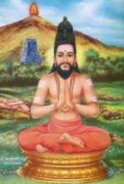

THE ESOTERIC
KANDAR ANUBHUTI
OR
THE SECRET TEACHING ON
GOD-EXPERIENCE
(A Treatise on Adwaitic Realization)
OF
SAINT ARUNAGIRINATHAR

 |  THE ESOTERIC KANDAR ANUBHUTI OR THE SECRET TEACHING ON GOD-EXPERIENCE (A Treatise on Adwaitic Realization) OF SAINT ARUNAGIRINATHAR |  |
 | by N.V. Karthikeyan |  |
| verses contents 3 4 5 6 7 8 9 10 11 12 .. 18 this verse in PDF version (4 parts) p-1 p-2 p-3 p-4 complete download of this book |
VERSE-8 அமரும்பதி கேள் அகமாம் எனுமிப் பிமரங்கெட மெய்ப்பொருள் பேசியவா குமரன் கிரிராச குமாரி மகன் சமரம்பொரு தானவ நாசகனே.Amarum pathi kel akamaam enumip- , Pimaram keda meyipporul pesiyavaa Kumaran giri-raasa kumaari makan, Samaram poru thaanava naasakane. The dwelling body and relatives, to regard as I (and mine) Commentary Unrestrained charity has expanded the Sadhaka's heart and made him unselfish. Contemplation on (the Feet of) the Lord has strengthened his love for God and correspondingly has weakened his attachment to his family. Thus the practice of charity and contemplation for quite some time (Verse-7) renders him fit to receive God's grace, which comes in the form of a Guru who gives him suitable instructions. Either he approaches a holy man for instructions or some holy man happens to meet him and gives advice. In either case, it happens due to God's grace, though he does not know it now. (Verses 13 and 17 will make it clear.) The Guru instructs him on the nature of Reality, that he is the Atman or Self, which instruction (temporarily) removes his deluded understanding that he is the body and that the family, wealth, etc. belong to him. This instruction does not cause an actual destruction of his ignorance but only gives him an intellectual understanding that he is the Self and not the body, etc. This is the initial advice given by the Guru and it is an external one, i.e., it is a verbal instruction (Pesudhal). That the grace of God has come in the form of the Guru and given him the instruction is, however, not as yet known to the aspirant; it is revealed to him only later on, in verse 13. The Guru's upadesa lifts his mind to such heights that he feels, though for the time being, he is freed from delusion. It is because of the mighty spiritual presence of the Guru and the power of his instructions, even if the Guru be God Himself. But the disciple soon reverts to his old condition, of course, with a clear knowledge of the existence and nature of higher realities, for attaining which Sadhana has to be done. This is quite evident from the case of Arjuna, who in the battlefield of Kurukshetra, was given the highest gospel, which contains all the wisdom in the universe, by no less a person than Yogeshvara Krishna Himself. It seemed to Arjuna then that all his doubts were clear, and he also declared that his ignorance was gone. But what was his condition after the Mahabharata war? He was once again the same old Arjuna! It is so because the universal vision and the wisdom were not attained as a result of Sadhana, but was temporarily "given" by the Lord, as an encouragement, by His divine power. The Guru's initial instruction is like a huge stone dropped in a tank whose waters are completely covered by moss, which disperses the moss for a while and the water is temporarily made visible but is soon covered by the moss again. This, however, has given a knowledge of the fact of there being water beneath the moss, which was not even known before. So is the case with the Guru's powerful instruction on reality which makes the aspirant feel, at least for the time being, that he is the Self, and not the body, etc. This would become clear from the next verse. At the first contact, the Guru gives what is called the Hitopadesa, i.e., 'speaks' some words of wisdom, which gives immense solace to the disturbed mind of the aspirant. The Guru only "speaks" about the nature of reality. He does not, at once, give actual "initiation," which is Upadesa in the true sense of the term, which he does after due preparation of the student (verse 20). Very appropriately, the saint uses the word "speak" ('meipporul pesudhal') in this verse and in verse 11; and the word "initiate" ('upadesam unarthudhal') in verse 20. 'Kumara' means "one who is of eternal youth," who is ever the same, who knows no change - the Absolute. Kumara, again, means one who destroys evil. Ignorance is the highest evil and is the cause of Jivatva. It is due to ignorance that one regards oneself as the body; one's wife, one's children, and one's home as real, as one's beloveds, and as belonging to oneself. The Lord destroys this illusion by putting an end to the root-cause, viz. ignorance by His upadesa about one's real nature or identity. We have seen in the Kaappu Verse that from the Tejas that emanated from the third eye of Siva, the Avatara of Lord Skanda took place in the Saravanappoigai as six babies lying on six lotuses. When Parvati came, with Siva, and took the six babies, they assumed a single body with six faces and twelve hands. He was known as Shanmukha (the six-face Lord) and referred to in this verse as 'the Son of Parvathi, daughter of Himavan'. Later on Lord Skanda fought with the Asuras and destroyed Surapadman and his retinue. He also annihilates the demons of ignorance, lust, greed, etc., in the inner battle of the seeker. Hence, He is spoken of as 'the destroyer of Asuras'. Arunagirinathar's addressing the Lord, in the second half of the verse, in three different aspects has a great spiritual significance. The Lord is: 1. Kumaran (the Eternal-aspect, as He ever is, i.e., the Absolute); 2. Son of Parvati (the Avatara-aspect, i.e. materialization or manifestation of the Absolute or Pure Consciousness, in the relative plane for the "good" of the world); 3. Destroyer of Asuras (the Guru-aspect, who by His upadesa destroys the Asuras of ignorance, etc. of the seeker). He, thus, brings out the great truth that the Eternal Reality manifests itself as an Avatara and also comes as one's personal Guru; yet, it is the self-same Reality. But this is implied and not openly said here, which is clearly made explicit in Verse-13. The Lord, who is thus the Absolute and the Guru, gave instructions, which removed his delusion. Due to ignorance, the body is mistaken as the "Self" or "I" and vice-versa; and as a consequence, the people related to it as "mine." But the body is Jada (inert) because it can neither know itself nor other things. It appears to be conscious on account of the Atman (consciousness) which temporarily dwells in it and animates it. Hence, the body is not the Self, but only an abode for it. But due to ignorance, the nature of which is indescribable, the Self has come to regard itself as the body, etc. This misconception is called Bhrama in Sanskrit, which in the verse has been turned into "Pimara" to be in conformity with poetic rules. The Guru's instruction dispels this ignorance. The first line of the verse is usually interpreted as, "…the delusion on account of which one erroneously thinks that this is my dear native place, (these are my) beloved relatives and (this is my) dear house has been destroyed." When the mind gets purified to some extent by charity and contemplation, the Lord appears as one's Guru. The Guru is God manifesting himself in a human form. Guru and incarnations of God should not therefore be regarded as mere human personalities, which error an aspirant generally commits. Bhagavan Sri Krishna says, "Fools disregard Me, clad in human form, not knowing My higher Being as the Great Lord of beings." (Gita IX-11). The neophyte on the spiritual path cannot comprehend the highest reality, all of a sudden. The mind, in the initial stages, needs a more concrete form to perceive, adore, serve, move with and meditate upon. Hence, God comes as the Guru; and the Guru should be regarded as such. The Supreme Reality takes an Avatara and again comes in human form as one's Guru to guide the aspirant to realise God. God comes down to our level to take us to His level. |
| contents 3 4 5 6 7 8 9 10 11 12 .. 18 this verse in PDF version (4 parts) p-1 p-2 p-3 p-4 |
| ... www.kaumaram.com ... The website for Lord Murugan and His Devotees முகப்பு கௌமாரம் அட்டவணை மேலே தேடல் home Kaumaram contents top search |
Kaumaram.com is a non-commercial website. This website is a dedication of Love for Lord Murugan. Please take note that Kaumaram.com DOES NOT solicit any funding, DIRECTLY or INDIRECTLY. |